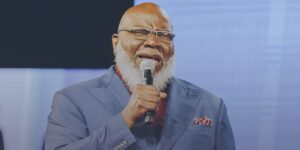Confronting ‘Separation of Church and State’ Myth
On Wednesday June 19, Governor Jeff Landry of Louisiana signed into law a bill requiring the Ten Commandments to be displayed in all public schools. Secular organizations like the ACLU immediately threatened lawsuits because, according to them, it violates the “separation of church and state.”
However, the phrase “separation of church and state” is nowhere to be found in America’s founding documents. It was never used by any of the Founding Fathers. It is a myth created by anti-Christian activists who want to purge the nation of its Christian heritage.
A Distortion of Jefferson’s Words
The phrase is a distortion of Jefferson’s words in a letter to the Danbury Baptist Association of Connecticut dated Jan. 1, 1802. In the letter, Jefferson addressed the Baptists’ concerns about how they would be treated in the new nation.
Breaking news, Spirit-filled stories. Subscribe to Charisma on YouTube now!
They had reason for concern for, throughout Europe, the Baptists had been an outlawed Christian sect, severely persecuted by the state and the state-sanctioned churches, both Catholic and Protestant. They were imprisoned and put to death because they refused to conform to the official church doctrines and practices imposed by the state.
In his response, Jefferson quoted that part of the First Amendment that reads, “Congress shall make no law respecting an establishment of religion or prohibiting the free exercise thereof.” He assured the Baptists that this meant that, in America, a “wall of separation” had been erected that would protect them from the intrusion of the state.
Jefferson’s “wall of separation” was obviously unidirectional, put in place to keep the government out of the church, not to keep God out of the government. His own actions affirm this, for as president, he took money from the federal treasury to pay for a missionary to the Kaskaskia Indian tribe and to build a church building for them in which to worship (Hyatt, “1726: The Year that Defined America,” 149).
The View of the Founders Is Clear
The words and deeds of the founders make it clear that they never intended a “separation of church and state.” When George Washington took the first presidential oath of office with his hand on the Bible and swore to protect and defend the Constitution, it expressed his belief that only the Bible, including the Ten Commandments, provided the moral and intellectual underpinnings for a stable and prosperous nation.
Demonstrating that they had no intention of separating God from government, the day after ratifying the First Amendment, the founders proclaimed a National Day of Thanksgiving and Prayer. They did not want an official state church like the nations of Europe, but they had no intention of eliminating God from the public square.
John Adams expressed the consensus of the founders when he said, “Our Constitution was made only for a religious and moral people. It is wholly inadequate for the government of any other” (Hyatt, 168). Their position was also confirmed by Justice Joseph Story (1779-1845) who served as a Supreme Court Justice for 34 years from 1811-1845. Commenting on the First Amendment, Story said, “We are not to attribute this prohibition of a national religious establishment to an indifference in religion, and especially to Christianity, which none could hold in more reverence than the framers of the Constitution” (Hyatt, 152).
The Summation of the Matter
Gov. Landry is to be applauded for his courage and insight. The removal of prayer, Bible reading and Christian symbols from the classrooms, beginning in 1963, has led to an abysmal and deadly deterioration of both morals and academics. America’s root problem is neither political or economic, but spiritual and moral. God bless Gov. Landry for taking steps to get at the root of the problem. Jefferson would wholeheartedly agree!
Join Charisma Magazine Online to follow everything the Holy Spirit is doing around the world!
Dr. Eddie Hyatt is an author, Bible teacher and revivalist who is convinced that God is not finished with America. This article is derived from his book, “1726: The Year that Defined America,” available from Amazon and his website at http://eddiehyatt.com.






































